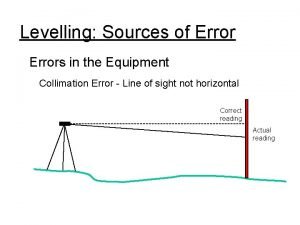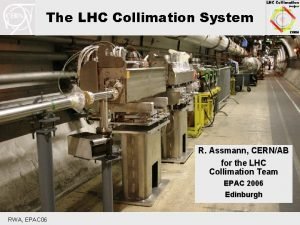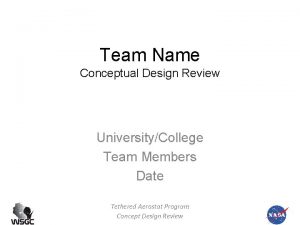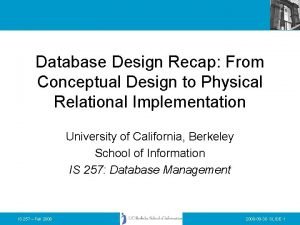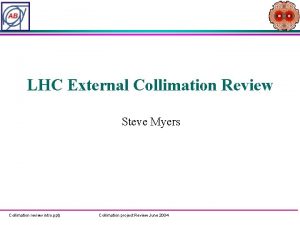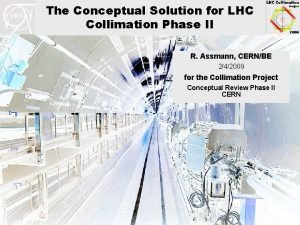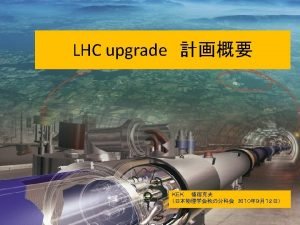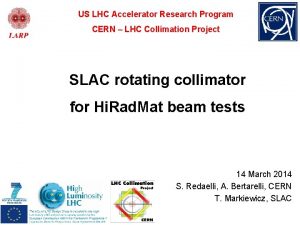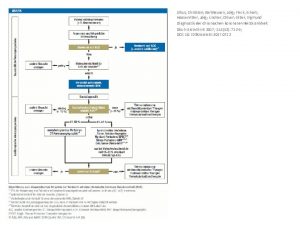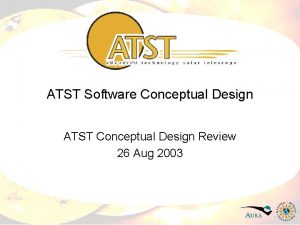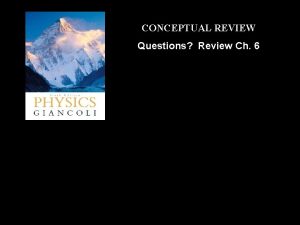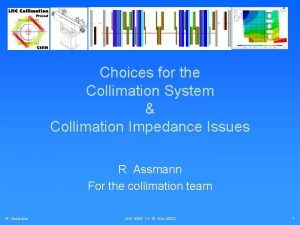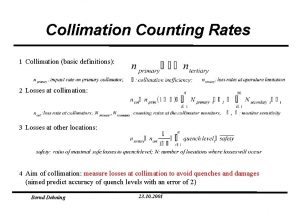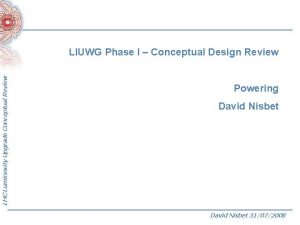Conceptual Design Review LHC Phase II Collimation Jrg












- Slides: 12

Conceptual Design Review LHC Phase II Collimation Jörg Wenninger CERN Beams Department Operations group Machine Protection Aspects April 2 nd 2009 Collimation Review - J. Wenninger 1

MPS @ LHC q The MPS at the LHC must fulfill the daunting task of protecting the LHC against a beam with 200 times more stored energy than present state-of-the-art. pp, ep, and ppbar collider history 2008 1992 SC magnets 1971 1987 1981 April 2 nd 2009 Collimation Review - J. Wenninger 2

MPS @ LHC q Coordinated MPS activities started ~2001 and progressed alongside with the collimation system that also underwent a major re-design (Copper Carbon). q A large effort went into the analysis and simulation of failures and into the design of a redundant protection wherever this was possible. o q Example: Most critical normal-conducting magnet circuits were protected by ad-hoc fast failures detection systems (‘FMCM’). A major uncertainty is the knowledge of damage limits for many components (in particular SC magnets !!). o What beam intensity is safe at 7 Te. V? Present assumption is that even the smallest bunch should be handled with care… o We are clearly lacking experimental tests. April 2 nd 2009 Collimation Review - J. Wenninger 3

Timescales @ LHC Time 10000 turns = 0. 89 s Operational ‘mistakes’ 1000 turns 10 turns Quenches Power converter interlocks Quench protection NC magnet powering failures FMCM 1 turn = 89 ms April 2 nd 2009 Kicker magnets BLMs BPMs Collimation Review - J. Wenninger Absorbers 4

Collimators & BIS Timing LHC LHC Devices SMP Safe Beam Flag Software Interlocks Movable Devices SEQ via GMT BCM Beam Loss Experimental Magnets CCC Transverse Operator Experiments Feedback Buttons Collimator Positions Beam Aperture Kickers Environmental parameters Collimation System BTV screens FBCM Lifetime Mirrors BTV MKI Beam Dumping System Beam Interlock System Injection BIS PIC essential + auxiliary circuits WIC Magnets QPS (several 1000) FMCM Power Converters Power AUG Converters ~1500 April 2 nd 2009 RF System UPS Cryo OK BLM Monitors aperture limits (some 100) BPM in IR 6 Monitors in arcs (several 1000) Doors Access System EIS Collimation Review - J. Wenninger Vacuum System Vacuum Valves (~300) Timing System (PM) Access Safety Blocks RF /e. Stoppers 5

Multistage cleaning & protection q Beam propagation Core To clean efficiently collimators are the objects that are closest to the beams. >> Exposed to uncontrolled beam loss !! >> First in line for most MP incidents. Primary halo (p) CFC April 2 nd 2009 CFC e Absorber e p Shower Secondary collimator Secondary p halo p Shower p Primary collimator Impact parameter ≤ 1 mm Very important for MP since collimators are designed to be robust!! Tertiary halo p Superconducting magnets W/Cu Collimation Review - J. Wenninger Absorber Unavoidable losses SC magnets and particle physics exp. W/Cu 6

MPS Failure Categories q Single turn (single-passage) beam loss o ‘Failures’ of kicker magnets (injection, dump or aperture). • Asynchronous beam dumps. o Injection failures. >> Collimators are very exposed and must survive impacts: q - Injection : 450 Ge. V beam of 2 MJ. - Asynchronous dump : ~ 5 -10 bunches, ~1 MJ at 7 Te. V. Beam loss over many turns (fastest ~ 20 -30 turns) o Simulations with nominal phase 1 collimators indicate that collimators are hit first in the large majority of cases: collimators very effectively define the machine aperture. • Exceptions : local bumps. o BLMs at or downstream of collimators used to trigger dump. April 2 nd 2009 Collimation Review - J. Wenninger 7

Asynchronous dumps Protection in the event of an asynchronous firing of one of the 15 dump kickers (expected ~ 1 / year): q Moveable graphite absorber TCDQ, plus secondary collimator (TCS). q Tertiary collimators protect the triplets (mainly IR 5) against beam leaking out of absorbers + coll. Issue : TCDQ is single sided, protection against beam moving away from the jaw is far from perfect (hard limit from TCS may not be sufficiently tight). April 2 nd 2009 Collimation Review - J. Wenninger 8

Simulation result example PHD - A. Gomez Orbit along the ring Orbit around collimators Collimator jaw April 2 nd 2009 Collimation Review - J. Wenninger 9

Simulation result example Integrated loss on the collimators during powering failures PHD - A. Gomez April 2 nd 2009 Collimation Review - J. Wenninger 10

Phase II Collimation q Phase II collimation may lead to an increase of the stored energy by a factor 10 or more. o Phase II primary and secondary collimators must be robust. o One should not count at the same time on an increase of current and a reduced impact of failures on the collimators. • By that time we will have experience with MP at the LHC, but it is not evident that it allows relaxing robustness. q Integrated BPMs. o Excellent for positioning the beam and ensuring jaws are centered. o One should consider: • upgrading the secondary collimators behind the TCDQ absorbers to improve the protection against asynchronous beam dumps. • the possibility of defining a fast interlock on the beam position inside the collimators. April 2 nd 2009 Collimation Review - J. Wenninger 11

Summary q The LHC MPS relies heavily on (robust) collimators for passive protection and as interceptors in case of uncontrolled beam loss, even more so when the intensity will go up with phase II. o Collimators define the aperture ! q To be sure that a collimator is robust experimental validation is more than an asset! o Test facility would be of interest to many people, and not just at CERN. q The integrated BPM solution should be contemplated for the collimators at the TCDQ (+ TCDQ itself…) and to develop a fast interlock on the beam position (at least for selected jaws). April 2 nd 2009 Collimation Review - J. Wenninger 12
 Sextant parts
Sextant parts Levelling
Levelling Star testing astronomical telescopes
Star testing astronomical telescopes And a modular collimation system
And a modular collimation system Conceptual design review template
Conceptual design review template Conceptual design review
Conceptual design review Libidau
Libidau Normal phase vs reverse phase chromatography
Normal phase vs reverse phase chromatography M tswett pronunciation
M tswett pronunciation Mobile phase and stationary phase
Mobile phase and stationary phase Chromatography means
Chromatography means Normal phase vs reverse phase chromatography
Normal phase vs reverse phase chromatography Line current and phase current
Line current and phase current

